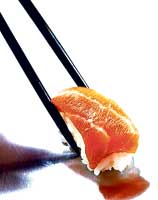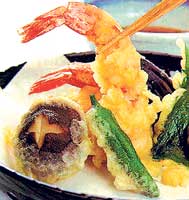
Yummy - Chowing downJust looking at Japanese food, it is easy to see how appearance is important and can be considered an art form of sorts. The slicing methods for foods like vegetable and sashimi, the three-dimensional from, colour patterns, carefully selected tableware all contribute to this 'art form.' Grains, vegetables and fish and limiting the use of cooking oils is important to this cuisine. There is interest around the world for Japanese cuisine, mainly because the food is nutritionally balanced, with it being rich in vegetable fat, protein and fibre and also low in calories and animal fat. Sushi
Two of the most famous types of Japanese foods are sushi and tempura. Sushi is a display of culinary artisanship while tempura is a colourful dish which give you the ability to relish the flavours of the season. When you visit a sushi bar, you can watch how the sushi chef distinctly prepares the ingredients, where a hand-rolled ball of vinegared rice (shari) is topped with a carefully prepared slice of seafood or other topping, called neta. The neta is bought freshly and a wide variety of seafood can be savoured every season. The idea behind preparing sushi is a process which has been traced back to China and Southeast Asia, to preserve and ferment fish with salt and rice. In fact, even today, such fish and rice fermentation dishes exist. It is interesting to note that there is in fact a science behind the process where the vinegar from the fermenting rice breaks the fish down into amino acids thus resulting into one of the five basic tastes (umami). Narezushi can be considered the oldest form of sushi in Japan, this then evolved into Oshizushi and what we call sushi today, Edomae nigirizushi. A condiment for sushi and sashimi is wasabi a green coloured paste which is accompanied with soy sauce. Wasabi is unique to Japan and grown naturally along river beds. This green paste has a pungent bite and a distinct aroma, and is used to give an accent of sorts, to the delicate flavours of the food and is said to kill bacteria in the food. Tempura Tempura is basically, vegetables or seafood deep-fried in a think coating of batter. Seasonally available vegetables and seafood are used for this dish therefore giving a chance to relish the flavours of each season. This can be eaten either, dipped in sauce, broth or salt, eaten as a separate dish or served on top of rice or noodles. Tempura is said to have started out as a simple and quick meal, of deep-fried seafood, which was served at stalls on the streets, during the Edo period.
Rice, fruits and seafood are the main elements of Japanese cuisine while two of the most important seasonings are, soy sauce and miso. Japanese soy sauce is made by fermenting soybeans and wheat with koji mold and is a brown liquid. Miso is made by fermenting and aging a mixture of soybeans, salt and koji mold. Koji is steamed rice that has had koji-kin, or koji mold spores, cultivated onto it, which break the starch in rice into sugars, that can be fermented by the yeast cells, which then give off carbon dioxide and alcohol. Japanese rice Unlike the rice we eat everyday here in Sri Lanka, Japanese rice is ashort-grained and sticky and become glutinous when cooked and is an important part of Japanese food culture. The rice is basically served in a bowl and eaten alongside other dishes but can be mixed with others dishes. Different fruits can be found in Japan, in the four distinct seasons, therefore a variety of flavours can be enjoyed throughout the year. A lot of effort is put into taking care of these fruits and can even be considered, handcrafted gems! Some of the fruits available in the distinct seasons are as follows: In spring – strawberries and cherries, in summer – watermelons, peaches and melons, while in autumn – grapes and persimmons (which is a soft distinctly sweet fruit, which contains vitamin C and is considered ideal for relieving hangovers!), in winter – apples and tangerines can be found. Japanese pears are found in summer and autumn and in comparison to the European variety, which is more often processed, are very succulent when eaten raw, and have a distinctive crispness and rich in fibre. Sea food and Japanese longevity Seafood (fish and shellfish) has been a very important aspect of Japanese food, for many centuries, due to it being a long island chain. The secret behind Japanese longevity is said to be the consumption of seafood. In fact, the world now looks towards seafood, as it is low in fat and calories, and has an abundance of nutrients. There are a number of methods used in preparing seafood, such as sashimi, grilling, stewing or deep-frying. Sashimi basically, fresh raw seafood and is thinly sliced. Sashimi is served with a mixture of soy sauce and wasabi or ginger. It originated as a meal for fishermen who were out at sea. When it comes to grilling, it is done over and open flame. Stewing is done by using various ingredients in a broth of water, dashi (stock) and seasoning. What happens here is that the richness of the broth gets fused with the flavour of the ingredients. Deep frying is done in a pot of hot oil. This allows the flavour to be locked in and gives a nice crispiness on the outside while the inside is tender. |
|| Front
Page | News | Editorial | Columns | Sports | Plus | Financial
Times | International | Mirror | TV
Times | Funday
Times || |
| |
Reproduction of articles permitted when used without any alterations to contents and the source. |
© Copyright
2007 | Wijeya
Newspapers Ltd.Colombo. Sri Lanka. All Rights Reserved. |

